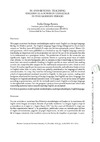Please use this identifier to cite or link to this item:
https://accedacris.ulpgc.es/jspui/handle/10553/69406
| DC Field | Value | Language |
|---|---|---|
| dc.contributor.author | Ortega Barrera, Ivalla | en_US |
| dc.date.accessioned | 2020-01-27T16:49:18Z | - |
| dc.date.available | 2020-01-27T16:49:18Z | - |
| dc.date.issued | 2015 | en_US |
| dc.identifier.issn | 0211-5913 | en_US |
| dc.identifier.other | Dialnet | - |
| dc.identifier.uri | https://accedacris.ulpgc.es/handle/10553/69406 | - |
| dc.description.abstract | En este artículo se examinan las diferentes metodologías utilizadas en la enseñanza del inglés como lengua extranjera durante el período moderno. La lengua inglesa empezó a extenderse en el siglo XVI. Según Bauer (23) “the first years of Elizabeth I’s reign saw further expansionist moves” y las gramáticas, publicadas como un método para utilizar el inglés correctamente, jugaron un papel importante, no sólo en la promoción del uso de la lengua vernácula sino también como una forma de impulsar su prestigio. La producción de libros escritos en lengua vernácula en este período (siglo XVIII) era mayor que en épocas anteriores gracias al incremento de la clase media (nueva burguesía), capaz de adquirir más conocimiento para aumentar su estatus social. Leer en inglés se consideraba más natural que hacerlo en otras lenguas que eran menos comprensibles para aquellos que no sabían Latín, Griego o Francés. Es bastante significativa la enorme cantidad de libros científicos y prácticos escritos en inglés y no en latín, considerada como la lengua de la comunicación científica. El intento por imitar las prácticas del continente se refleja en las innumerables traducciones al inglés. En este contexto, el comercio con países extranjeros estimuló el aprendizaje de lenguas extranjeras, pero la lengua inglesa también era una lengua que los foráneos, tanto en Inglaterra como fuera de sus fronteras, querían aprender. En este artículo, revisaré (a) el estatus del inglés según los autores de libros de gramática y (b) los métodos utilizados para enseñar inglés como lengua extranjera en el siglo XVIII. Para ello, analizaré once libros impresos de los cuales he extraído los datos sobre la visión de sus autores hacia la enseñanza del inglés. | en_US |
| dc.description.abstract | This paper examines the diverse methodologies used to teach English as a foreign language during the Modern period. The English language began being widespread in the sixteenth century as “the first years of Elizabeth I’s reign saw further expansionist moves” (Bauer 23), and grammars, which were published as a method to use the English language correctly, would play an important role in the promotion not only of the use of the vernacular but also in its endorsement as a prestigious variety. The production of books in the vernacular was significantly higher than in previous centuries thanks to a growing social mass of middle class citizens, i.e. the new bourgeoisie, able to consume as much knowledge as they could to meet their new social standards. Reading in English was felt as more natural than reading in other less comprehensible tongues for the traditionally unlearned in Latin, Greek or even French. It is rather significant the enormous amount of scientific and utilitarian books written in English rather than in Latin, which was globally considered as the language of scientific communication. In a way, they were but imitating Continental practices, and this involved a bulk of unprecedented translated material in English. In this same context, trading with foreigners stimulated the learning of foreign languages, but English was also a language that foreigners in England and abroad wanted to learn. In this paper I revise (a) the status of English according to grammarians, and (b) the methods used to teach English as a foreign language in the eighteenth century. For this purpose I analyse eleven printed books from which data concerning authorial stance towards teaching English are excerpted. | en_US |
| dc.language | spa | en_US |
| dc.relation.ispartof | Revista canaria de estudios ingleses | en_US |
| dc.source | Revista Canaria de Estudios Ingleses [ISSN 0211-5913] (71), p. 13-28 | en_US |
| dc.subject | 5701 Lingüística aplicada | en_US |
| dc.subject.other | Grammar | en_US |
| dc.subject.other | Modern period | en_US |
| dc.subject.other | Standardisation | en_US |
| dc.subject.other | Teaching methodologies | en_US |
| dc.subject.other | English language | en_US |
| dc.subject.other | Gramática | en_US |
| dc.subject.other | Periodo moderno | en_US |
| dc.subject.other | Estandarización | en_US |
| dc.subject.other | Metodologías de la enseñanza | en_US |
| dc.subject.other | Lengua inglesa | en_US |
| dc.title | In and Beyond: Teaching English as a Foreign Language in the Modern Period | en_US |
| dc.type | info:eu-repo/semantics/article | en_US |
| dc.type | Article | en_US |
| dc.identifier.url | http://dialnet.unirioja.es/servlet/articulo?codigo=5302146 | - |
| dc.description.lastpage | 28 | - |
| dc.identifier.issue | 71 | - |
| dc.description.firstpage | 13 | - |
| dc.investigacion | Artes y Humanidades | en_US |
| dc.type2 | Artículo | en_US |
| dc.contributor.authordialnetid | 2562123 | - |
| dc.identifier.dialnet | 5302146ARTREV | - |
| dc.utils.revision | Sí | en_US |
| dc.identifier.ulpgc | Sí | es |
| dc.description.dialnetimpact | 0,0 | |
| dc.description.dialnetq | Q2 | |
| dc.description.erihplus | ERIH PLUS | |
| item.fulltext | Con texto completo | - |
| item.grantfulltext | open | - |
| crisitem.author.dept | GIR Discourse, Communication and Society | - |
| crisitem.author.dept | Departamento de Filología Moderna, Traducción e Interpretación | - |
| crisitem.author.orcid | 0000-0003-2155-9092 | - |
| crisitem.author.parentorg | Departamento de Filología Moderna, Traducción e Interpretación | - |
| crisitem.author.fullName | Ortega Barrera, María Ivalla | - |
| Appears in Collections: | Artículos | |
Page view(s)
74
checked on Mar 9, 2024
Download(s)
70
checked on Mar 9, 2024
Google ScholarTM
Check
Share
Export metadata
Items in accedaCRIS are protected by copyright, with all rights reserved, unless otherwise indicated.
